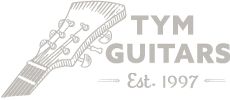60's-70's Guyatone LG-127Ts
Share
Yep, another Guyatone story. There's more coming too ...
Growing up as a young punk wanting to play a Mosrite in Australia these were one of our only options, along with the Onyx copies when they popped up in second hand shops. These weren't everywhere, but they did show up from time to time and do kinda look like a Mosrite.
A friend of mine Nick had a white one (which I still own) that he played live and I always loved the look of it on stage. It's obviously a slab body, like the Ventures model II, but meant to look like a Ventures with the angled neck pickup and scratchplate shape. I still love the shape of these.
These were made by Guyatone and first appeared in the '68 catalogue along side the LG-350 and the LG-150 and essentially replaced the LG-50 (more on them later) which had a thinner body and German carve but was the more primitive early to mid 60's Guyatone construction with gold foil pickups.

These have a thicker laminated "slab body" and feel and play better than the earlier 50's.
Mosrite were HUGE in Japan during the mid to late 60's and there were so many Mosrite copy and inspired guitars being made by Japanese manufacturers as the real thing was expensive and hard to get. While these copies are of course no match for a real Mosrite, they give a good representation aesthetically (some more than others) and were much cheaper.

These 127's were made in quite large numbers in both guitar and bass and remained almost unchanged throughout production, which ended in the mid 70's in a different factory, as explained in previous blogs.
The bolt on necks are Asian mahogany and are very comfortable and easy to play and all have a zero fret and string guide, like a real Mosrite. The headstocks are a simplified version with a rudimentary "M" cut in the end. The rosewood fretboards are always nice and they have small dot markers like a real Mosrite.

The pickups in these are a P-90, or Mosrite style metal covered single coil with great output and clarity. I'm a huge fan of a lot of Guyatone pickups and I think they made some of the best pickups from this era of the Japanese market.
The bridge is the standard Guyatone affair from this period and the vibrato is clearly based on the Fender offset unit and is well made and strong.
The laminated body and lack of German carve would have made these cheaper, and quicker to make and in '69 these were listed as 12,700 yen as apposed to the LG-150 at 17,000 yen or the LG-350 in the same catalogue listed at 35,000 yen.

Even still, they are a really well made guitar and play and sound great. I have seen these used live a lot, and seen them abused and toured and they hold up to punishment really well. The pickups tend to squeal a little with too much gain which may be the metal covers as other Guyatone pickups from this period can really hold lots of gain well. It's not really a drawback as you've gotta be driving them pretty hard and they do sound SO good.
As discussed in the LG-350 blog, once Guyatone shut down their factory in '69 these were made in a different factory and it's easy to tell 60's ones from 70's ones as the later have metal trussrod covers. All the other hardware, and quality in construction is identical except the scratchplate material changed slightly. I've owned quite a few of these over the years and I've never felt or heard any difference between pre '69 Guyatone built ones and later 70's Guyatone branded ones, and as I've said before, I'm a huge fan of both pre and post Guyatone made guitars.
Both of these are 100% original and in full working order, and they look, play and sound great.









